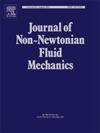非对称槽型超疏水通道粘塑性流体动力学控制
IF 2.7
2区 工程技术
Q2 MECHANICS
引用次数: 0
摘要
本文研究了粘塑性流体在具有横向沟槽结构的非对称超疏水(SH)壁面通道中的平面泊泽维尔流动。我们使用OpenFOAM模拟和Papanastasiou正则化方法来近似Bingham模型。针对上斜壁特征的变化,我们探讨了滑移数(b2)、槽周期长度(l2)、滑移面积分数(φ2)和Bingham数(B)对流动动力学、流动指标和未屈服中心塞形态的影响。结果表明,增大b2、φ2和φ2可以提高上斜壁的滑移速度,减小标准化塞面积(A/A0) (φ2=0.5),而增大B则会放大流动不对称、中心塞的移位和破裂。通过引入滑等效系统的概念,我们证明了不同的沟槽配置可以在不同的桥塞形态下产生相同的有效滑移长度(χT),从而实现粘塑性流体动力学的精确控制。我们推导了一个简化模型来预测χT和a /A0,确定了在a /A0≈0.68处的临界阈值,用于未破坏(状态I)和破坏(状态II)中心塞之间的状态转换,从而得到一个用于跨参数空间对这些状态进行分类的六维流形方程。本文章由计算机程序翻译,如有差异,请以英文原文为准。
Control of viscoplastic fluid dynamics in superhydrophobic channels with asymmetric groove configurations
We study the plane Poiseuille flow of viscoplastic fluids in channels with asymmetric superhydrophobic (SH) walls featuring transverse groove configurations in the thin channel limit. We use OpenFOAM simulations and the Papanastasiou regularization method to approximate the Bingham model. Focusing on variations in the upper SH wall’s characteristics, we explore the effects of slip number (), groove periodicity length (), slip area fraction (), and Bingham number () on flow dynamics, flow metrics and unyielded center plug morphology. We find that increasing , , and enhances slip velocity on the upper SH wall and reduces the normalized plug area () up to , while higher amplifies flow asymmetry, shifting and breaking center plugs. By introducing the concept of slippery equivalent systems, we demonstrate that varying groove configurations can yield identical effective slip lengths () with distinct plug morphologies, enabling precise control of viscoplastic fluid dynamics. We derive a simplified model to predict and , identifying a critical threshold at for regime transitions between unbroken (Regime I) and broken (Regime II) center plugs, leading to a six-dimensional manifold equation for classifying these regimes across parameter space.
求助全文
通过发布文献求助,成功后即可免费获取论文全文。
去求助
来源期刊
CiteScore
5.00
自引率
19.40%
发文量
109
审稿时长
61 days
期刊介绍:
The Journal of Non-Newtonian Fluid Mechanics publishes research on flowing soft matter systems. Submissions in all areas of flowing complex fluids are welcomed, including polymer melts and solutions, suspensions, colloids, surfactant solutions, biological fluids, gels, liquid crystals and granular materials. Flow problems relevant to microfluidics, lab-on-a-chip, nanofluidics, biological flows, geophysical flows, industrial processes and other applications are of interest.
Subjects considered suitable for the journal include the following (not necessarily in order of importance):
Theoretical, computational and experimental studies of naturally or technologically relevant flow problems where the non-Newtonian nature of the fluid is important in determining the character of the flow. We seek in particular studies that lend mechanistic insight into flow behavior in complex fluids or highlight flow phenomena unique to complex fluids. Examples include
Instabilities, unsteady and turbulent or chaotic flow characteristics in non-Newtonian fluids,
Multiphase flows involving complex fluids,
Problems involving transport phenomena such as heat and mass transfer and mixing, to the extent that the non-Newtonian flow behavior is central to the transport phenomena,
Novel flow situations that suggest the need for further theoretical study,
Practical situations of flow that are in need of systematic theoretical and experimental research. Such issues and developments commonly arise, for example, in the polymer processing, petroleum, pharmaceutical, biomedical and consumer product industries.

 求助内容:
求助内容: 应助结果提醒方式:
应助结果提醒方式:


